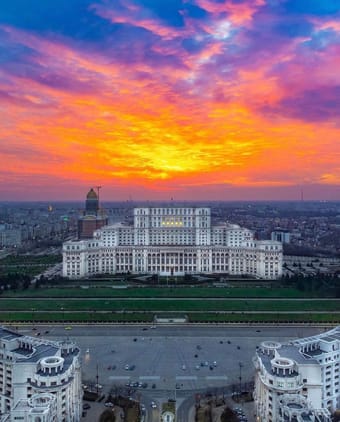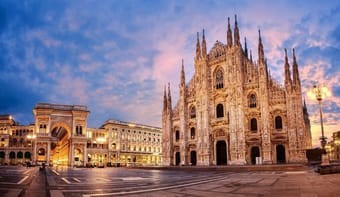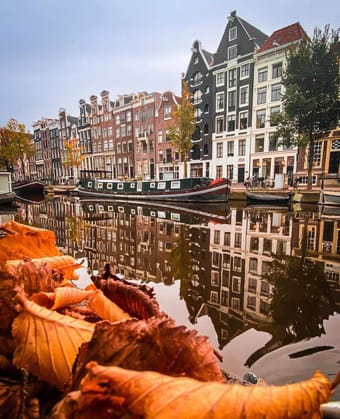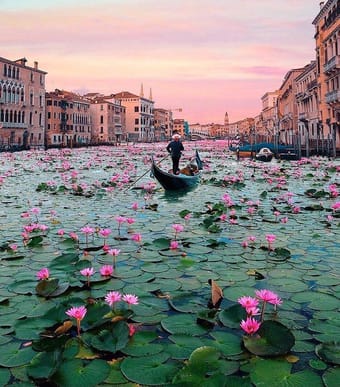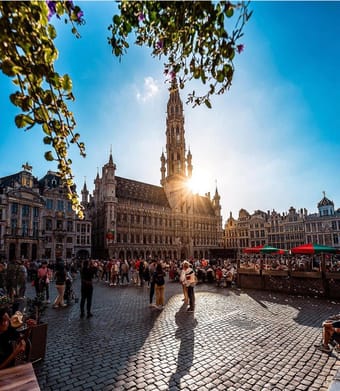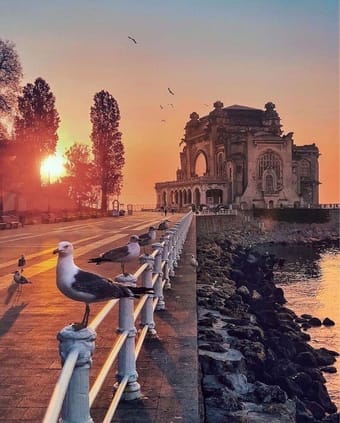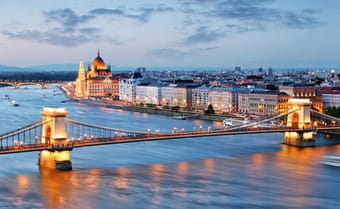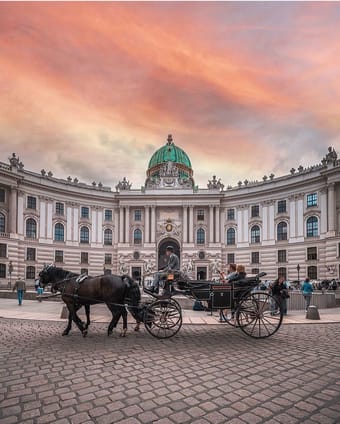Guides
The cradle of European civilization - Greece, embodies the ideal tourist destination in its capital, Athens.
One of the world’s oldest cities, it holds in so much history and hosts so many emblematic monuments for the ancient world that makes it so easy to believe that gods once really walked this land!
Amazing location (by the seaside), wonderful and warm people, great cuisine, lively nightlife, budget-friendly prices for everything - should I say more?
Free
0
Want to have a good time in Bucharest?
Have your check-in done 🛎️, sip a coffee, shop around and taste the busy life of the Romanian capital city - you’ll find this guide bursting with cool places, fancy restaurants and clubs 🪩 where you can go wearing all the pretty little things your money could buy (bespoke included - see below). You'll see that Romanians do have fun!
Highlights:
👚 Ia - the traditional Romanian blouse is more than just a piece of clothing; it is a national symbol, a story and a history book. Ia has a simple cut, and is usually white and made of hemp, flax cotton or silk, over which geometrical or floral motifs are embroidered in colored threads.Motifs differ from one region to another. The used ornaments, colors and materials represented a social mark, age, marital status, religious affiliation and place of origin within the country. There is also a day dedicated to the celebration of this shirt, namely the 24th of June.
🧆 Mititei/mici - (both Romanian words meaning "little ones", "small ones") is a dish from the Romanian cuisine, consisting of grilled ground meat rolls in cylindrical shape made from a mixture of pork/beef/lamb with spices such as garlic, black pepper, thyme, coriander, anise, savory, and sometimes a touch of paprika; often served with french fries, mustard and pickled vegetables.
Shopping
Free
18
Indulge yourself in the luxurious Italian lifestyle (as Milan is the wealthiest city in the country) and set your standards as high as the Milanese people do (epecially when it comes to fashion 🧥👠👜).
💶Shop 'til you drop in some of the best outlets/boutiques/flagship stores then spoil your taste buds with some glorious flavors that only the Lombardy area has to offer.
Free
8
This guide takes you on a sassy tour of the city of the canals or the “Venice of the North” - with a bit of something for everyone!
The city is famous for its arhitecture, art museums and traditions that are well kept alive and praised. But it is also famous for cannabis-serving coffeeshops (this guide provides a list with such venues), red-light district, quirky bars and bizarre museums.
So, whether on foot or by bike/boat, take this guide & stroll around this outstanding city in search for fun, food, souvenirs and all those Dutch vibes that you heard so much about.
When it comes to traditional food, be sure to try:
- Haring or 'Hollandse Nieuwe' (Dutch new herring), probably the most famous Dutch food. Pickled herring is a delicacy in Holland. The raw herring is served together with chopped raw onions and gherkins.
- Stamppot, an old dish of mashed potatoes combined with root vegetables, like turnip, carrot and onion, but it can also include dark, leafy greens like kale/spinach (make sure you order it the traditional way, with smoked sausage).
- Erwtensoep, a thick split pea soup;
- Bitterballen similar to a scotch egg, they are balls of finely chopped beef or veal that are seasoned with a mixture of spices, then rolled in bread crumbs and deep fried.
Also, make sure you try out some desserts:
- Poffertjes, small pancakes, baked in an iron skillet and traditionally served with melted butter, dusted with icing sugar
- Pannenkoeken, another traditional sort of pancakes
- Oliebollen ‘oil spheres' are balls of dumpling batter fried in hot oil and later sprinkled with icing sugar.
Highlights:
🌷Dutch tulips - It was in the 16th century that tulips were imported to Holland from the Ottoman Empire. In no time, tulips became the most sought-after commodity in the entire Netherlands, after Carolus Clusius wrote what's considered the first major book about the flower. In the early 1600s, professional cultivators of tulips began to refine techniques to grow and produce the flowers locally in Holland, establishing a flourishing business sector that has persisted to this day.
The tulips mostly bloom during the spring season, from mid-April to mid-May, in Amsterdam. The Tulip Festival will begin on March 23rd and go on till May 14th, 2023
👡 Klompen - Dutch clogs are a type of footwear made in part or completely from wood. The iconic footwear of the Netherlands were the shoes of choice for Dutch laborers of centuries past. The wooden slip-ons were sturdy, cheap and—when stuffed with straw—cozy and warm. The first Dutch clog is dated from the year 1230. The shoe is deeply ingrained in Dutch culture and some people in rural areas still wear them today!
🚲 Dutch bikes - are a style of urban commuting bikes that have been used in the Netherlands for decades and have grown in popularity in cities around the world. Dutch bicycles are upright or “sit-up” style – with taller frames than typical bicycles. This position allows for very good visibility and great comfort. A popular form of Dutch bicycles is the Omafiets (translates to Grandma's bike).
🗼 Dutch windmills - were built originally to pump the water out from the land because the Netherlands is so flat and below sea level. With the land always getting flooded, farming was almost impossible, hence the need to force out the water by means of the windmills.
🧇 Stroopwafel - the most classic of all Dutch sweets and a perfect gift from Holland - literally means “syrup waffle” and it’s a round crunchy waffle with chewy caramel filling. The correct way of eating it is: put it on your coffee or tea cup and wait for a minute until the caramel melts and the waffle warms up – it enhances its flavour and makes it taste as fresh from the oven. Delicious!
🧀 Dutch cheese - especially Gouda, Edam and Maasdam, well known and exported all over the world. Apart from the classics, try some really special ones: a turquoise-coloured cheese with lavender, pink-coloured cheese with red pesto, champagne gouda or even… coconut gouda! A typical cheese from Amsterdam is Old Amsterdam, exceptional premium aged gouda cheese.
🥃 Genever (also called Jenever) - is the traditional liquor of the Netherlands, from which gin has evolved. Some tasters say the flavor of this spirit is similar to white whiskey. Oude (old) genever is the traditional style, with a malty botanical flavor. Jonge (young) genever is a newer recipe with a cleaner taste, more similar to vodka.
There are several genever distilleries in Amsterdam, each with their own secret recipes.
Solo Female • Groups • Adventure • Architecture • Art • Foodie • History • Shopping
$10.00
22
Venice, also known as the "City of Canals”, “The Floating City” and "Serenissima”, is a place like no other - charming through its intricate alleys and walkways over the canals, with no cars/scooters or traffic noise to spoil the romance in the air. Gondolas floating here and there, idyllic cozy terraces just around every other corner, Italian delicacies all over and relaxed people wandering about.
Venice's culinary delights include Sarde in Saor, Risotto al nero di seppia (black squid ink risotto), Bigoli in salsa, Baccalà mantecato (whipped codfish), Fegato alla veneziana (liver with onions), and Risi e bisi. Don't miss cicchetti (small plates) and Tiramisu for dessert.
Highlights:
🍾 Bellini is the name of a cocktail invented in Venice about 80 years ago. A Bellini consists of peaches and Prosecco (Italian version of Champagne). The peaches are squeezed and the juice is mixed with Prosecco. The glasses in which the Bellini is served have to be very cold. For the typical Venetian Bellini only white peaches are used.
🛶 A gondola is a traditional narrow and long Venetian rowing boat. The boat is steered by one person called a gondolier with the help of one long oar. Centuries ago, gondolas were the main means of transport in Venice. Now they have become a very popular tourist attraction, and perhaps the most recognisable symbol of Venice.
Although a bit expensive (standard gondola rides in Venice have a fixed cost of 80 euros for a private 25-30 minutes tour. At night, however, the cost of a gondola ride is 120 euros for a private 25-30 minutes tour. If you desire to stay longer, tell the gondolier and ask for the price before the start of the tour) a gondola ride might just be the most romantic thing to do in Venice.
🥠Baicoli is a typical Venetian biscuit. The shape of the biscuit resembles that of a sea bass, hence the name - "baicoli" means "sea bass" in the Venetian dialect. Back in the old times, when Venetian sailors prepared for long journeys, the captains made sure to procure a lot of baicoli. The biscuits were used as bread, and because of being very dry, they could survive for a very long time. Baicoli are typically vanilla-flavored, and are sold in metal boxes, easy to transport and keep fresh for long. The metal boxes, in which the baicoli are sold today, carry a picture of Venetian men and women in traditional clothing of olden times.
Other traditional sweets to try: Mandorlato di Cologna Veneta (especially at Christmas).
🍘 Frittelle - They are Venetian doughnuts served only during Carnival. They can be stuffed with pistachio cream, zabaione and chocolate.
Free
13
Brussels: A city of contrasts, where the old and new harmonize, and the vibrant energy of its streets paints a kaleidoscope of experiences waiting to be explored!
Do explore day trips to Ghent & Brugge.
When it comes to cuisine, Belgium is famous for: cheese, mussels, rabbit stew, chocolate, waffles, fries, and boterhammen or tartines.
Btw - Brussels has more chocolate shops per square foot than any other city!!!
Free
9
From modern to traditional, from luxury to convenient…dining, shopping and sightseeing in this amazing city! You’ll find several options for great accommodation, as well.
Istanbul is where Europe meets Asia and here you'll encounter elements from both continents.
Mind yourself - this city is huge and really crowded. Traffic can be horrific at times and getting from one point to another could take up some time. Still, it's full of savory contrasts, echoes of the past and glimpses of the future and could easily get you addicted!
Highlights:
☕️ Turkish coffee - whether it’s made in sand, over fire or on stovetop, it is prepared in a “cezve” (ibrik) using very finely ground coffee beans without filtering;
🫖 Turkish tea - called “çay” (pronounced chai) in Turkish - is a kind of black tea brewed in a dual teapot and served in tulip-shaped small glasses called “ince belli”.
🥨 Simit (Turkish Bagel) a sesame-bathed, circular Turkish bread. Very common - the cheapest street food in Turkey.
🍥 Turkish delight - also called lokum, jellied confection with different flavours (may contain pieces of fruits/nuts) commonly found in the markets.
🥟 Baklava - is a layered pastry dessert made of filo pastry, filled with chopped nuts, and sweetened with syrup or honey. It was one of the most popular sweet pastries of Ottoman cuisine.
🏺 The Nargile, also known as hookah or hubble-bubble or sheesha or Turkish water pipe, is an old tradition in Turkey for smoking Turkish tobacco (plain or fruit flavored - with or without nicotine).
🧿 Evil Eye Symbol - the Nazar Boncuk symbolizes the jealous and envious look of others, which, according to the popular belief, would have the power to cause various misfortunes to a person or his property. Turkish people believe that this amulet protects its holder from the bad energies by absorbing them.
In addition, Turkey is famous for its sweets/desserts, ceramics, silver/gold jewelry, spices. Don’t forget to bargain - it is kind of a national sport. 😉
$8.50
24
Prague is definitely worth visiting. It is a beautiful city with rich history, stunning architecture, and cultural diversity. The city offers a range of activities, including sightseeing, exploring museums and galleries, enjoying the nightlife, and sampling delicious Czech cuisine. Additionally no, Prague is a relatively affordable city, making it an attractive travel destination for budget-conscious travelers.
Souvenirs you can bring home:
Bohemian Glass (near Prague, there are five Czech glass and crystal factories that can be visited), Prague Garnet (this precious gemstone is a symbol of the city’s rich cultural heritage), Mucha Posters by Alfons Mucha, Beer Cosmetics, Wooden Toys, Marionette Puppets, Karlovy Vary Spa Wafers, Kafka Museum Souvenirs, Special Reading Material from Palac Knih Luxor, Czech porcelain, the Prague golem, something with Krtek - the little mole (a famous cartoon character).
When it comes to food, be sure to check:
- Kolachkes (Traditional Czech Cookies) are small, sweet, and perfect for snacking on while exploring the city; made from a rich, buttery dough that is rolled into small balls and then filled with a variety of sweet fillings such as fruit preserves, nutella or poppy seeds (and are often sprinkled with powdered sugar for an extra touch of sweetness)
- Trdelník, made from a dough composed of yeast, flour, sugar, and eggs, the seemingly gourmet treat is wrapped around a spit and grilled until crispy on the outside and soft on the inside. Traditionally coated in sugar and cinnamon for a sweet and aromatic flavor.
Beverages? Beer, Becherovka (Herbal Liquor), Absinthe.
Highlights:
🍺 Beer - The Czechs will tell you that their beer is the best in the world, and they ought to know. Per capita, the Czech Republic consumes more beer than any other country. Pilsner Urquell, the worldʼs first pilsner beer, is top of the line; Gambrinus, made at the same brewery, is also good. The dark Krušovice has a surprisingly light quality; Budvar is the original Budweiser; and Staropramen is the Czech Republicʼs proud working-class brew. Small brewery labels, like Bernard and Lobkowicz, are also worth trying. Czech beer is rated by degrees – 10 degree, 11 degree, 12 degree – with the alcohol content increasing as the numbers rise.
🗿The Golem - Prague golem is a legendary figure in the city’s history and has become a popular souvenir for visitors. The Golem is said to have been created in the early 19th century by a rabbi named Judah Loew, who used the creature to protect the Jewish people from persecution. According to legend, the golem was made of clay and was brought to life through a magical ritual; it quickly became known for its immense strength and loyalty to its creator, but its power was also feared. Eventually, the rabbi realized he needed to destroy the creature before it caused any harm.
Today, the golem is a symbol of Jewish heritage and the power of folklore.
$7.50
21
The main destinations when visiting the Romanian seaside. 🌅 Below are all the best places: tourist attractions, dining/drinking spots and shops within and around the city.
Home of the famous NEVERSEA music festival that takes place every year (at the beggining of July), Constanta comes alive during the summer season. ⛱️ ☀️ It is a cultural conjunction of multiple ethnic traditions: Romanian, Greek, Turkish, Tatar, Aromanian. This stands out especially in the region’s cuisine, therefore you may find various dishes around here to delight your taste buds, no matter the preferences (don’t miss out on the seafood and fish-based menus available at many local venues called “cherhanale” 🐟).
Free
1
Wine, dine and party inside some of the most expensive and exquisite buildings/venues in the world! Then take yourself out shopping because this place is heaven for fashionistas and luxury brands lovers!
🚤 Make sure to check a private boat tour! Having a view over the city from between the waves is mesmerizing while the sunsets feel more personal than ever!
Free
3
Spending some time in beautiful Florence? This is a complete list that provides you with a handful of options: accommodation, tourist attractions, shops, bars and restaurants - you’ll need no other guide, I promise!
So…have a bite and a drink alongside Arno river and take home the most impressive bespoke souvenirs. The city blends art and history and romantic vibes all together and pretty soon you’ll find yourself in love. 💓
Must do - trips to picturesque towns located nearby:
• San Gimignano: 1h away
• Siena: 1h10 away
• Volterra: 1h20 away
Highlights:
⚜️ Il Giglio - giglio bottonato, is mainly known from the crest of the city of Florence. In the Florentine fleurs-de-lis, the stamens are always posed between the petals. This is also the emblem of the city and you shall see it depicted all over.
🍨 Gelato “crema fiorentina” - is the specific flavor of Florence, made with a simple combination of egg yolks, milk, and sugar. It is often flavored with chestnut honey, while another common addition includes crumbled amaretti cookies or almond liqueur. It is a neutral ice cream flavor with delicate pale-yellow color.
🍧 Affogato - a delightful and simple Italian dessert or beverage that combines two beloved elements: espresso and gelato or ice cream. The word "affogato" in Italian means "drowned," and that perfectly describes the preparation of this delicious treat. The basic affogato recipe involves pouring a hot, freshly brewed espresso over a scoop of cold gelato or ice cream. The hot espresso contrasts with the cold and creamy gelato, resulting in a harmonious and satisfying flavour combination.
🥩 Bistecca alla fiorentina - Italian steak made of young steer (vitellone) or heifer (scottona) that, combined with the specific preparation, makes it one of the most popular dishes of Tuscan cuisine.
🍷 "Buchette del vino" - or wine windows, are a peculiar feature of Florence. They are foot-high, dome-shaped holes in the thick, stone palazzi of the Renaissance city that six centuries ago were used to sell wine in a fiasco (glass bottle) without having to open a shop and avoid paying taxes.
These wine windows also posed a useful anti-contagion way to sell wine during the epidemic of 1630-1633. At that time, the bubonic plague hit Florence hard, killing 12% of the city's population.
Romantic
Free
15
Fascinating places in Rome - a little bit of this, a little bit of that, mixing classics with some unpopular, hidden gems!
Where to eat/drink (including a bunch of beautiful rooftops), where to shop (outlets, bespoke & made in Italy - brands you rarely find outside this country) and what to visit around (gorgeous sights included, so be sure to check them out and take lots of pictures).
Highlights:
🛵 Vespa - is an Italian luxury brand of scooters and mopeds manufactured by Piaggio. The name means wasp in Italian. An Italian icon since 1946. You’ll see many of these all over the city.
🍕 Roman style Pizza - we encounter "pizza al taglio," which means "by the cut". The scizzas, which are a type of scissors, are used to cut this pizza into square-shaped slices. This helps to maintain the structure of both the toppings and the crust. There is also “pizza bassa”, with a thin base. Roman pizza is practically the opposite to Neapolitan pizza: it is crispy and they are not afraid of toppings. A classic on all menus in Rome is the Capricciosa: topped with ham, mushrooms, olives, artichoke, an egg and tomato. Oil is added to the dough and there is much less water than the Naples version.
🥯 The maritozzo - is a classic sweet pastry, traditionally packed full of whipped cream, which has satisfied Romans for centuries. The dough-based bun is typically eaten in Rome for breakfast but can also be eaten as a hefty snack, or dessert, throughout the day.
☕️ Ristretto - is Italian for "short shots", and that's exactly what this shot of espresso brings to the table. Its main difference is that it takes a shorter extraction time, and uses less water therefore the flavor is rich and bold, and very intense.
🍧 La Grattachecca Romana - a favourite icy drink with fruity flavor; for the Romans, the grattachecca is sacred - strictly prepared by hand in the historical kiosks of the Rioni Trastevere, Testaccio and Prati, in the lively Ponte Milvio area and Trieste and Trionfale districts. Grattachecca derives, in fact, from the action with which the “ghiacciata" (ice) is produced: with a special tool, the ice is scraped off a block, called the "checca" in Roman dialect.
🛍️ When it comes to shopping, Rome can be quite the haven for designer brands, but there is no other fashion house more Roman than Valentino Garavani. The brand’s design (its famous studs) has its origins in the Renaissance architecture of Rome - the “bugnato” technique of the ancient Roman buildings. The largest Valentino store (in the world) lies here, in Rome, on the famous Piazza di Spagna site.
$7.50
18
Barcelona - the capital of Catalonia - is a vibrant and dynamic city, full of exciting things to do. From its stunning architecture to its delicious food and lively culture, there's never a dull moment in this city. Visitors can explore iconic landmarks such as the Sagrada Familia and Palau Nacional, or stroll along the famous La Rambla promenade, taking in the sights and sounds of street performers and vendors. Barcelona is also renowned for its art scene, with world-class museums and galleries showcasing the works of famous artists like Picasso and Miro.
Catalans have their own traditional dishes. Chief among them is pork sausage both cooked (butifarra) and cured (fuet), as well as the ubiquitous pa amb tomàquet (pan con tomate in Spanish), grilled bread rubbed with tomato and garlic, drizzled with olive oil, and sprinkled with sea salt.
For something more local, try fideuà, essentially the Catalan version of paella, made with short noodles instead of rice.
Make sure to sweeten up your trip with:
- xuxo: traditional Catalan pastry with sweet cream filling and sugar coating;
- mel i mato: dessert made from fresh goat cheese drizzled with honey;
- tarta de Santiago: a Galician almond cake made with ground almonds;
- panellets: small, round pastries made from ground almonds and flavored with coffee or lemon
For drinks, have a vermut (vermouth) instead of sangria; it's served over ice and garnished with a slice of orange and/or olives.
Also, you can try Cava, which got its name back in 1970 with the idea of distinguishing it from French champagne, the word meaning ‘Cave’ or ‘cellar’. Cava is rapidly gaining prominence in the world and rivaling champagne, 95% of all Catalan cava is made in Penedès in the vineyards surrounding the village of Sant Sadurní d'Anoia, close to Barcelona.
🏵️ The famous Antoni Gaudí - Spanish architect and designer from Catalonia, known as the greatest exponent of Catalan Modernism - worked almost entirely in or near Barcelona, therefore the city boasts with his works: Casa Batlló, Casa Milá La Pedrera (you can grasp a sight of the interior while having a coffee at Cafe de la Pedrera
DON'T MISS: the gift shop is amazing), Casa Vicens, Park Güell, Sagrada Família church, etc.
⚽️ For football enthusiats: you have to take a look around Camp Nou.
💡A trip to Abbey of Montserrat would also make a great idea.
⛱️Perhaps a day trip to Costa Brava (90 min by bus)?! 😎
$7.50
23
Enjoy some “tres jolie” days walking around the Parisian streets and boost up your energy level 🔋 with some coffee just after/before a “little” shopping spree.
This list includes many of the city’s cafes (Paris is now a specialty coffee - and pastry - capital) and all the good spots to shop something that will surely indulge all of your needs/senses (main focus on French brands).
💡Be sure to check the vintage selling gems spreaded all over Paris!!!
💰 By the way, massive sales happen twice a year in France: in July and January. Called “les soldes” in French, the sales normally last around four weeks and the discounts increase as the weeks pass.
Even if you don’t catch the sales, designer shops give you the opportunity of buying small accesories (keychains for example), leather goods (belts, gloves, card holders, passport covers, etc) or scarves/caps/ties - even umbrellas, which make for exceptional souvenirs.
Perhaps you can even get the chance of seeing the “art of making” a product in the workshop/workroom of the artisans.
Plus, visiting the shopping venues could turn into an amazing experience as many of them are soooo Instagrammable!
Highlights:
🥐 Croissant - is a buttery, flaky, viennoiserie pastry inspired by the shape of the Austrian kipferl but using the French yeast-leavened laminated dough. Croissants are named for their historical crescent shape. The modern croissant seems to have been created by the French chef Sylvain Claudius Goy.
🥖 Baguette - is a long, thin type of bread of French origin that is commonly made from basic lean dough (the dough, though not the shape, is defined by French law). It is distinguishable by its length and crisp crust.
🧀 Fromage de France - there are more than 1,000 kinds of cheese in France! Being in Paris is being in the Ville des Fromages, the City of Cheese. Some of the most known: Camembert,
Brie de Meaux, Roquefort, Reblochon, Munster, Pont l'Évêque, Époisses de Bourgogne, Comté.
Tip: go for a “cheese and wine” tasting.
🐌 Escargot - any of several species of edible land snails, a delicacy of French cuisine. Although the snails eaten as escargots are terrestrial, they are technically mollusks and therefore classified as seafood.
🍷 French wine - France is one of the largest wine producers in the world. Red wines from grape varieties like Pinot Noir, Cabernet Sauvignon, Merlot, Zinfandel. Rosé wines like the Provençal rosé and the sweet White Zinfandels. White wines like a Chardonnay, Riesling, Sauvignon Blanc, or a Moscato. Sparkling wines from Champagne and Vouvray.
Shopping • Coffee
$7.50
28
A merger of two old cities in 1873 - Buda and Pest, separated by the Danube River - the capital of Hungary seems like a place out of a fairy tale. 🏰
With some castles here and some other majestic buildings there, I found it to be an elegant, chic and romantic city, with different cultural influences (such as Roman, Ottoman, Slavic, Jewish and Austrian).
Known as the “Paris of the East” or the “Pearl of the Danube”, the city is also designated as the “City of SPAs”, therefore this guide includes a list of some famous thermal baths and SPAs, alongside dining/drinking and shopping venues. Of course, all the major tourist attractions are included, as well.
🌶️Hungarian cuisine is synonymous with paprika.
Few cuisines are quite so intertwined with a single ingredient as Hungary’s is with paprika — the spice that gives some of the country’s best-known dishes their intense orange colour and characteristic peppery flavour. Paprika is made from the dried ground pods of several types of capsicum annuum pepper, and it comes in a range of heat levels from édes (sweet) to csipos (hot) and different levels of coarseness.
In Budapest it’s sold everywhere, from small grocery stores to local food markets, where small-scale producers sell it by the kilogram in unlabelled plastic bags. For the highest quality, seek reputable family producers such as Hódi or PaprikaMolnár.
Free
4
An extra-full guide on where to wine&dine in central London and beyond (no matter the 💷: from low budgets to gold/platinum card holders 😄). And the list is big because…this is the most exhilarating city I have ever visited! I bet you will find your favorites among mine!
Highlights:
🫖 English breakfast tea - it is actually a blend of various kinds of black tea; is meant to be had with milk and sugar although it can be served without either.
🥓 Full English Breakfast - this usually includes: bacon, sausages, eggs, baked beans, toast, mushrooms, tomatoes, hash browns and black puddings.
🥧 British Pies - from fish to cheese and onion to minced beef or steak, savory pies are a British tradition that’s been around for centuries. By far, some of the most popular pies are the Shepherd’s Pie/Cottage Pie and the British Mushroom and Chicken Pie.
🐟 Fish & chips - this dish is a must try whilst you are in the UK; no matter where you are, you’ll be able to find a delicious plate of fish and chips.
Shopping
$12.00
34
The ‘City of Dreams’ - Vienna - is the capital of Austria, famous for its Imperial history and architecture, profound musical heritage, vibrant art scene and irresistible aromas wafting from traditional coffee houses.
Otherwise - a very neat and tidy city, systematically organized in all its urban details, with righteousness reigning all over. It gives an elitist vibe that not many other cities could compete with!
Highlights:
🎼 Mozart and Beethoven, some of the biggest composers in the world.
Wolfgang Mozart: born in 1756 in Salzburg, moved to Vienna aged 25. Many landmarks in Vienna are dedicated to him, including Mozarthaus Vienna (a museum that was formerly his residence) and the Operahouse (which exhibits his works).
Ludwig van Beethoven: born in 1770 in Germany, he spent the majority of his life in Vienna, where he lived. He was a composer and pianist who was famous despite the adversity in his life, namely losing his hearing at 28 and eventually becoming entirely deaf. Nonetheless, he continued to write influential music.
🍲 Wiener schnitzel - Austria’s national dish, known as Viennese schnitzel, is always veal as opposed to regular schnitzel (pounded flat, coated in breadcrumbs and fried). Often, it is served with fried eggs, a potato salad, or a green salad.
🫔 Apple Strudel - The oldest recipe for apple strudel is available at the Vienna Town Hall Library, written in 1697. As a result, the iconic dish remains one of the most celebrated desserts that Vienna is famous for offering, especially in coffeehouses. The pastry is filled with a sweet apple filling and traditionally has intricately woven designs.
🍬 Mozartkugel - is the nation's most crucial dessert. Mozartkugel (as the name translates) are traditionally made from marzipan balls covered in chocolate icing and wrapped by hand.
🥃 Schnapps - in Austria it is what Vodka is to Russia, and especially for those who love a good drink, look no further than a bottle of Austrian schnapps. A distilled spirit made by fermenting freshly picked fruit, it is easy to drink, and has the profile of a light-flavoured vodka.
Free
9
Only the best spots to shop, wine, dine and get hyped up in the Spanish capital - a modern city that honors its historical heritage.
Passionate people from Madrid are all about getting together, enjoying life and art in all its forms. Regardless of the season, Madrid abounds in art venues, cultural manifestations and night life. However, a little bit of shopping won’t hurt either. 😉
Highlights:
🐻 El Oso y el Madroño (the Bear and the Strawberry Tree) - the symbol of the city, is a sculpture from the 2nd half of the 20th century, that represents the coat of arms of Madrid and is found on the east side of the Puerta del Sol, between Calle de Alcalá and Carrera de San Jerónimo, in the historical centre of the capital.
🐂 Corrida de toros - Spanish-style bullfighting, involves a physical contest with humans (and other animals) attempting to publicly subdue, immobilize, or kill a bull. The most common bull used is the Spanish Fighting Bull (Toro Bravo), a type of cattle native to the Iberian Peninsula. This style of bullfighting is seen to be both a sport and performance art. In a traditional corrida, three toreros (or matadores) each "fight" against two out of a total of six "fighting" bulls to death.
💃🏻Flamenco - is an art form (incorporating poetry, singing, guitar playing, dance, polyrhythmic hand-clapping and finger snapping) strongly influenced by the Gitanos, but which has its deeper roots in Moorish musical traditions. Flamenco culture originated in Andalusia, but has since become one of the icons of Spanish music and even Spanish culture in general.
🍖Jamón - is a kind of dry-cured ham that’s at the heart of Spanish culture and cuisine. There exist two great traditions of artisanal cured hams in Spain, both of which are a source of enjoyment and great pride among Spaniards:
1. Jamón Serrano - a cured country ham made from conventional pork.
2. Jamón Ibérico - produced from non-acorn fed pigs (Cerdo Ibérico) or acorn-fed variety which results in Jamón Ibérico de Bellota (considered the world's finest ham).
🥨 Churros - is a type of fried dough, made with choux pastry dough piped into hot oil with a piping bag and large closed star tip or similar shape. They can either be thin (and sometimes knotted) or long and thick, where they are known as porras or jeringos in some regions. Normally eaten for breakfast dipped in champurrado, hot chocolate, dulce de leche or café con leche.
🏟️ Football fans should be very excited about Madrid, as it hosts one of the best teams ever - Real Madrid. Visit Real Madrid’s home by taking a tour on their stadium, Santiago Bernabéu.
$7.50
19
Complete guide with attractions and venues where to eat/drink, get those very special souvenirs from (bespoke & local brands and markets) and catch a beautiful sight…or just your breath after walking up and down the hills of this marvellous city. Lisbon is all about art, colors, architecture and GOOD vibes! 🇵🇹💚
💡General tip: combine Lisbon with visits/stays in Sintra and Porto.
Highlights:
🚋 Trams - The Lisbon tramway network is a system of trams in operation since 1873; it presently comprises six lines and has a length of 31 km with 63 trams in operation (45 historic "Remodelados", 8 historic "Ligeiros" and 10 modern articulated trams). Tram 28 is famous because happens to go past many of the city's most significant landmarks in districts like Alfama, Baixa and Estrela. Because the route also uses some heritage-style tram carriages, it has become a popular tourist attraction in the city.
💠 Azulejos - is a form of Spanish and Portuguese painted tin-glazed ceramic tilework. Azulejos happen to be one of the most distinctive art forms in Portugal and are found on the interior and exterior of churches, palaces, ordinary houses, schools, and nowadays, restaurants, bars and even railways or subway stations.
🧼 Soaps - Oprah Winfrey said they're one of her favorite things, so the world is now also a fan of Portuguese soaps. But they're not recent products. They've been made since the 1800s and are 100% natural. They've maintained beautiful Art Deco and Art Nouveau packagings from the 1920s, and have become one of the favorite gifts to take from Portugal.
🥮 Pastel de nata - is a Portuguese egg custard tart pastry, optionally dusted with cinnamon - looks like a cross between a custard tart and a cake; created by monks in the Jerónimos Monastery, a major tourist attraction today and a UNESCO World Heritage Site.
🍲You also have to try these traditional dishes: Bifana, Sardines, Caracoletas & Prego na Pao, Alheira de Mirandela, Queijadas.
🧉Ginja - also known as ginjinha. This sour cherry liqueur is a tourist favorite but has sweetened locals’ palates for a long time too. There are establishments in Lisbon entirely dedicated to selling this sweet beverage made with Morello cherries, a variety of spices, and plenty of sugar. Nowadays, ginja is also served in edible chocolate cups. While you may choose among white chocolate, milk chocolate and dark chocolate, dark chocolate does indeed pair beautifully with the super sweet, almost syrupy drink.
Shopping
$12.00
18
Here is the list with all the classic Must Do’s in London - museums, religious sites, art galleries, theatres and even cinemas.
I would definitely recommend sightseeing London by boat, as well. A cruise on the Thames can easily make your whole experience a great one! You can use the Oyster Card (valid for any means of transportation in London) to travel in between objectives by boat: from Westminster pier to Greenwich pier for example. So, using the Oyster Card on the Thames Clippers River Bus services: only touch in with your card on the yellow card reader when asked to do so by a member of staff and remember to touch out again at the end of your journey.
History • Art
Free
4
Want to enjoy the most amazing views over the city of lights and love? ❤️🇫🇷 Shed away any fear of heights and follow the way 🆙 Your experience in Paris wouldn’t be complete otherwise, so…whether by day or by night, here are some of the most amazing upper spots where you could wine, dine and soak up the city’s romantic energy. On trinque? 🥂
$5.50
17

Laura Dehelean
52 Subscribers
Constanța, Romania
Identity Verified
DESTINATIONS
Constanța, Romania
Italy
Spain
Portugal
United Kingdom
Romania
France
Turkey
Czech Republic
Netherlands
Greece
FOCUSES & SPECIALTIES
Budget
People & Culture
Coffee
Shopping
Foodie
Car-free
Accessibility
Art
Wine
Relaxation
LANGUAGES
Romanian
English
Italian

